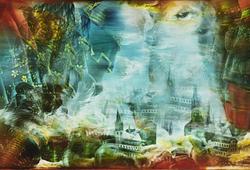A bronze sculpture of a guardsman, Ming dynasty (1368-1644).
Dressed in armoured robes with billowing scarf and ornate headdress, holding a sword. Height with wooden stand 27 cm. Weight with wooden stand 1480 gram.
Traces of gilding and paint. Damages.
Alkuperä - Provenienssi
Property of a private Swedish collector.
Purchased in Hong Kong January 14th 1966.
Muut tiedot
This bronze statue depicts the real historical figure of the military General Guan Yu (died AD 219) who became glorified in the Ming Dynasty (1368-1644) historical novel Romance of the Three Kingdoms, attributed to Luo Guanzhong.
Under the late Ming Emperor Wanli (r. 1572-1620) Guan Yu was transformed into a deity and as such his honorific name was changed from 'Guan Gong' or Duke Guan, to the grander 'Guandi' or Lord Guan. This rise in the cult worship of Guan Yu stemmed in part from the looming military threat of the Manchus in the north-east of China; and pirates that raided deep into the coastal regions. Whenever there was a foreign military incursion therefore, China's military heroes were resuscitated.



















































